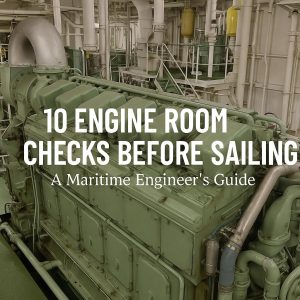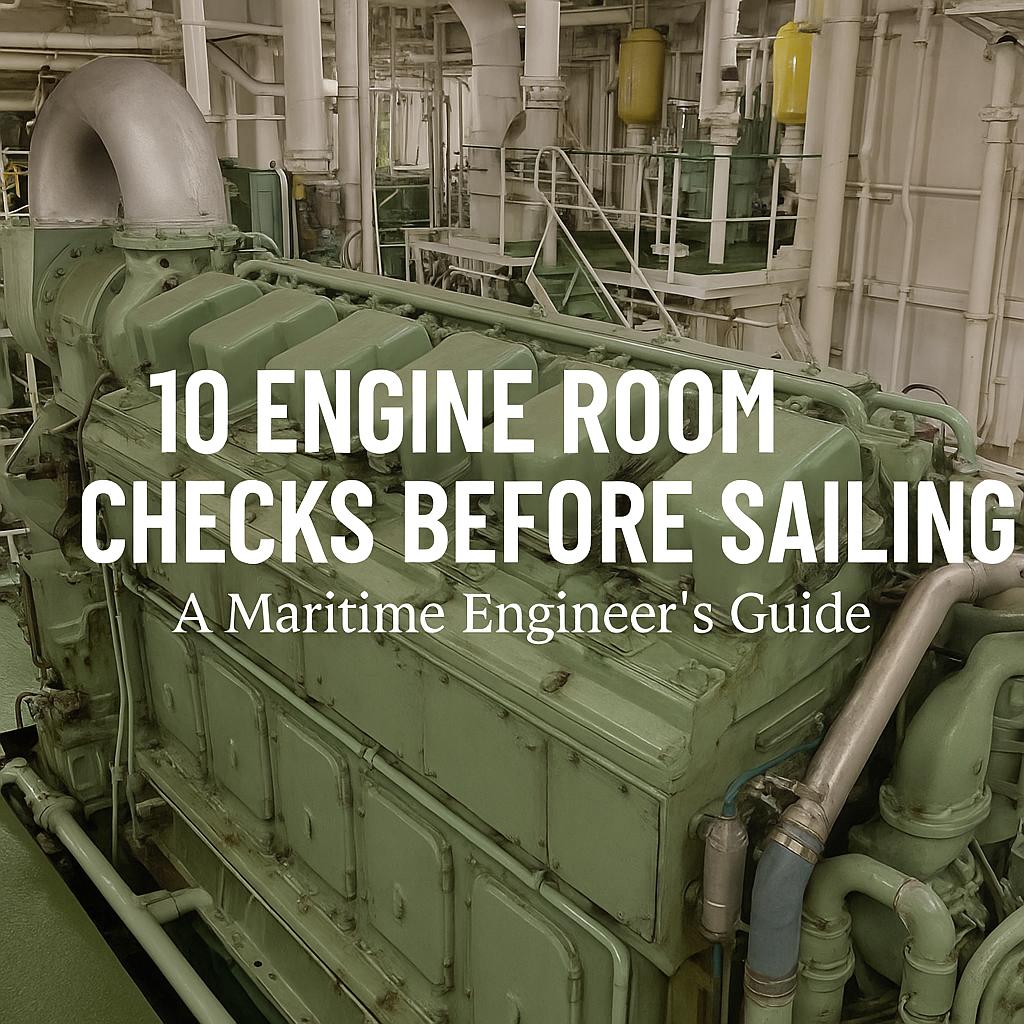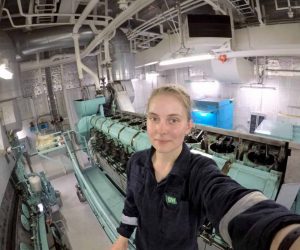Ensure safe and efficient vessel operations with the top 10 engine room checks before departure. Learn how these critical inspections protect crew, machinery, and cargo in this maritime engineer’s essential guide.

Why Engine Room Checks Matter in Modern Maritime Operations
The engine room is the heartbeat of any merchant vessel. It powers propulsion, generates electricity, regulates shipboard systems, and supports safety equipment. Before a vessel leaves port, it’s the responsibility of the engineering team—led by the Chief Engineer and supported by duty engineers and cadets—to ensure that all machinery and critical systems are ready for sea.
Neglecting pre-departure engine room checks can lead to mechanical failures, delays, or worse—accidents at sea. The International Maritime Organization (IMO) and classification societies like DNV and Lloyd’s Register emphasize that routine pre-sailing checks are essential for compliance with international standards such as the ISM Code and SOLAS Chapter II-1 (Construction – Subdivision and Stability, Machinery and Electrical Installations).
In this article, we explore the top 10 engine room checks every engineer must complete before sailing, along with real-world insights, recent developments, and actionable tips.
The Importance of Engine Room & Marine Engines Proper Maintenance
Imagine departing a congested port like Singapore or Rotterdam, only for the main engine to stall mid-manoeuvre due to neglected maintenance—perhaps a clogged fuel filter or critically low lube oil pressure. The consequences can be catastrophic: grounding, collisions, millions in damages, severe reputational harm, and even hefty environmental penalties.
Proper engine room maintenance is not just a routine task—it’s a critical safeguard against operational disasters. Consistent and thorough upkeep of marine engines ensures:
✔ Regulatory Compliance – Meeting stringent maritime standards to avoid fines and detentions.
✔ Equipment Longevity – Preventing premature wear and costly breakdowns.
✔ Fuel Efficiency – Optimizing combustion and reducing operational costs.
✔ Operational Safety – Mitigating risks of mechanical failure in high-stakes environments.
Ignoring maintenance is a gamble no ship operator can afford. Proactive care of engine room systems isn’t just best practice—it’s a non-negotiable pillar of safe, efficient, and compliant maritime operations.
By prioritizing proper maintenance, you protect your vessel, your crew, and your bottom line. Don’t wait for a crisis—act before the alarm sounds.
–
Marine Diesel Engines Operation -Checks
–
Top 10 Engine Room Checks Before Departure
1. Main Engine Lubrication and Oil Levels
Before departure, verify:
-
Lube oil levels in main engine sump tank
-
Quality of oil (check for contamination, foaming, or water ingress)
-
Functioning of oil pumps and coolers
-
Lube oil pressure gauges and alarms
📘 Tip: Use visual sight glasses, lab samples (if time permits), and digital sensors to confirm oil condition and volume.
2. Fuel System Integrity
Fuel quality and delivery are foundational to engine performance. Check:
-
Settling and service tank levels
-
Transfer pump operation
-
Fuel viscosity and temperature (especially for HFO operations)
-
Cleanliness of filters and strainers
-
Leakages in pipelines or injector return lines
🚢 Analogy: Think of this check as verifying the “blood vessels” of your engine—any blockage or contamination affects the entire system.
3. Cooling Water System (Jacket and Seawater)
Cooling systems prevent engine overheating and maintain thermal balance. Inspect:
-
Levels in expansion tanks
-
Functioning of freshwater and seawater pumps
-
Sea chest strainers for marine growth or debris
-
Temperature differentials across heat exchangers
📘 Refer to IMO Model Course 7.02 for cooling system design standards and troubleshooting strategies.
4. Air Start System Pressure and Leak Test
Main engines rely on compressed air for starting. Before departure:
-
Check air bottle pressures (typically >30 bar)
-
Inspect piping and non-return valves for leaks
-
Test air compressors and safety valves
-
Drain condensate from air receivers
💡 Failure Case: A VLCC recently delayed departure due to air compressor overheating traced to a stuck suction valve—preventable with proper checks.
5. Steering Gear Function Test
Although part of deck-side operations, engineering must ensure:
-
Hydraulic oil levels in steering gear tank
-
Pump operation and standby unit readiness
-
Emergency power source for steering
-
Alarm and indicator tests
🔧 SOLAS Chapter V mandates steering gear tests within 12 hours before departure.
6. Emergency Generator Readiness
In case of blackout, the emergency generator supplies critical systems like:
-
Navigation lights
-
Communication equipment
-
Fire detection and suppression systems
Check:
-
Fuel and oil levels
-
Battery voltage
-
Auto-start function
-
Manual start capability
📘 SOLAS II-1/43 requires that emergency sources be independent, with a minimum 18-hour supply.
7. Bilge System and Pump Operation
Unattended bilge accumulation can signal hull breaches or lead to flooding. Ensure:
-
Bilge wells are clean and dry
-
Bilge pumps are operational (manual and automatic)
-
Alarms for high bilge levels are tested
-
Overboard valves are properly marked and sealed (ISM compliance)
⚠️ Real-World Insight: A bulker once faced MARPOL violations due to unnoticed bilge discharge caused by a stuck auto-pump relay.
8. Main Engine Turning and Blow-Through
Turn the main engine using turning gear to:
-
Ensure free rotation
-
Dislodge water accumulation
-
Detect potential obstructions
Blow through using compressed air (for 2-stroke engines) to evacuate any liquid from combustion chambers—a critical pre-start step.
🔍 Look for unusual resistance or metallic sounds, which may indicate internal damage.
9. Instrumentation and Alarms Check
Today’s engine rooms are data-rich environments. Before sailing:
-
Test sensors for temperature, pressure, RPM, and flow
-
Check bridge and engine control room alarm panels
-
Simulate common faults to test system response
-
Ensure engine telegraph and control interface are functional
📘 Classification societies like DNV mandate periodic validation of engine room monitoring systems, especially for UMS (Unmanned Machinery Space) ships.
10. Firefighting and Emergency Equipment in Engine Room
Last but not least, check readiness of safety gear:
-
CO₂ system: Cylinder pressure, pilot valve status, remote release lines
-
Fire extinguishers: Accessibility and pressure gauge
-
SCBA and emergency escape hoods
-
Fire dampers and emergency stops for fuel pumps and blowers
🔥 Drill Tip: Practice a rapid-response fire drill scenario as part of your departure prep.
Case Study: Avoiding Engine Room Disaster Through Routine Checks
In 2023, a geared bulk carrier departing Santos, Brazil experienced a main engine start failure due to a cracked high-pressure fuel line. Fortunately, the standby third engineer had completed a pre-departure inspection and noticed abnormal pressure drops. The issue was resolved before cast-off, saving the company from costly delays and potential engine room damage.
Frequently Asked Questions (FAQ)
Q1: How long do engine room checks take before sailing?
A: Depending on vessel size and complexity, checks typically take 1 to 3 hours, including system warm-ups and documentation.
Q2: Who is responsible for conducting these checks?
A: The Second Engineer usually oversees the process, supported by the Duty Engineer and Oiler. The Chief Engineer signs off before final readiness.
Q3: Are these checks mandatory under maritime law?
A: Yes. SOLAS, ISM, and Flag State regulations require pre-departure safety and machinery readiness checks.
Q4: Can digital monitoring replace manual checks?
A: No. While CBM (Condition-Based Monitoring) aids decision-making, visual inspection and physical testing remain essential.
Q5: What happens if a vessel departs with a known engine defect?
A: It may violate ISM/SOLAS codes and could lead to detention during PSC inspections or result in heavy fines and legal liabilities.
Conclusion
Every successful sailing begins below deck. The top 10 engine room checks covered here aren’t just operational routines—they’re essential for safety, compliance, and the prevention of costly failures at sea. A proactive engineering team ensures that the vessel not only departs safely but also performs efficiently throughout the voyage.
Whether you’re a cadet shadowing your first duty watch or a chief engineer preparing for Class renewal, committing to thorough pre-departure inspections reflects professionalism, responsibility, and care for both crew and cargo.
⚙️ For checklists, simulation modules, or engine room training guides, visit MaritimEducation.com and upgrade your operational readiness.
References
-
International Maritime Organization. (2023). SOLAS Chapter II-1: Machinery and Electrical Installations. https://www.imo.org
-
DNV. (2023). Marine Equipment Certification Guidelines. https://www.dnv.com
-
Lloyd’s Register. (2022). Ship Emergency Preparedness Standards. https://www.lr.org
-
IMO Model Course 7.02. Officer in Charge of an Engineering Watch. (2021 Edition)


